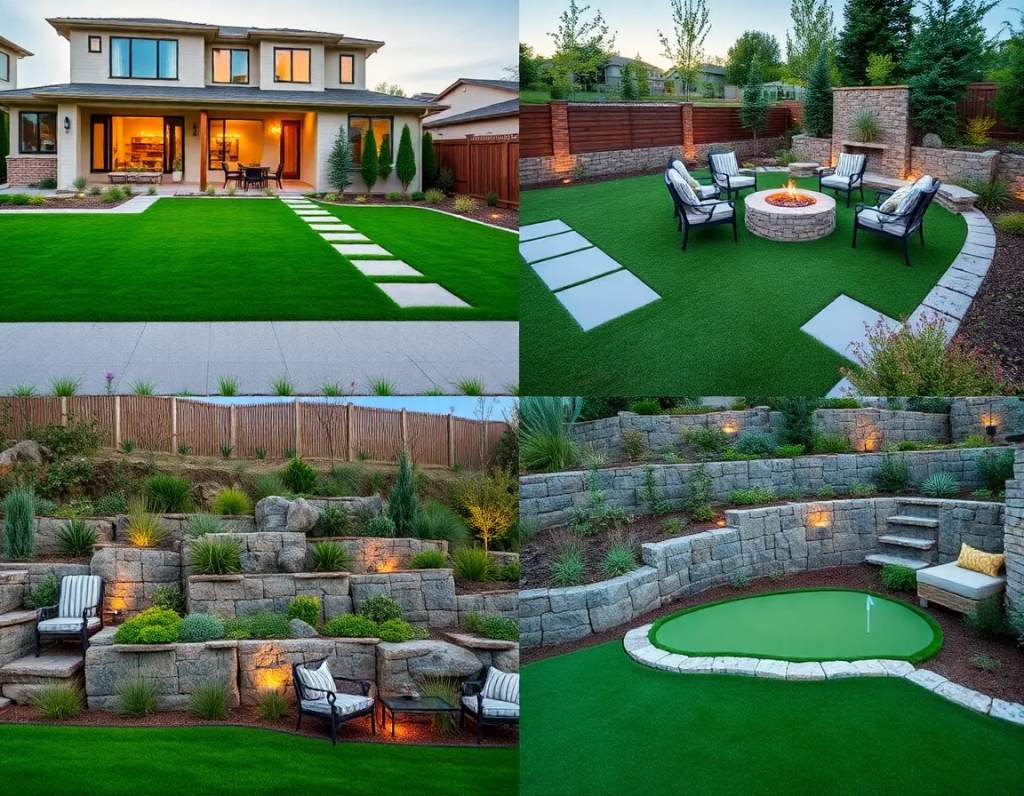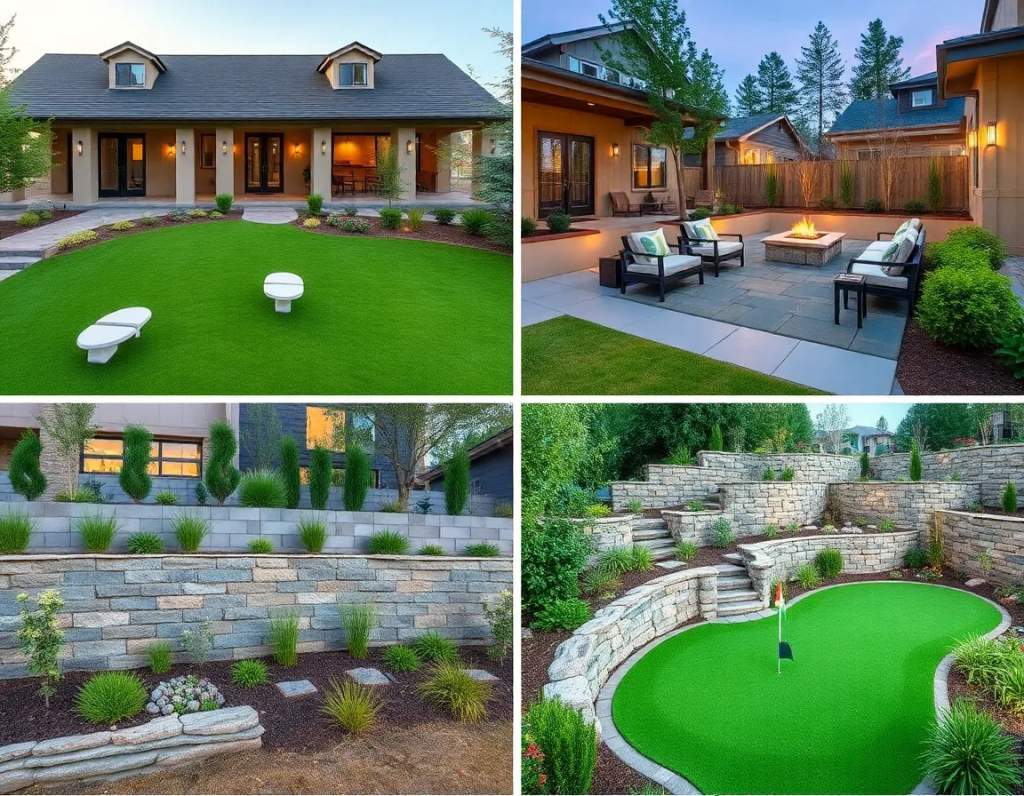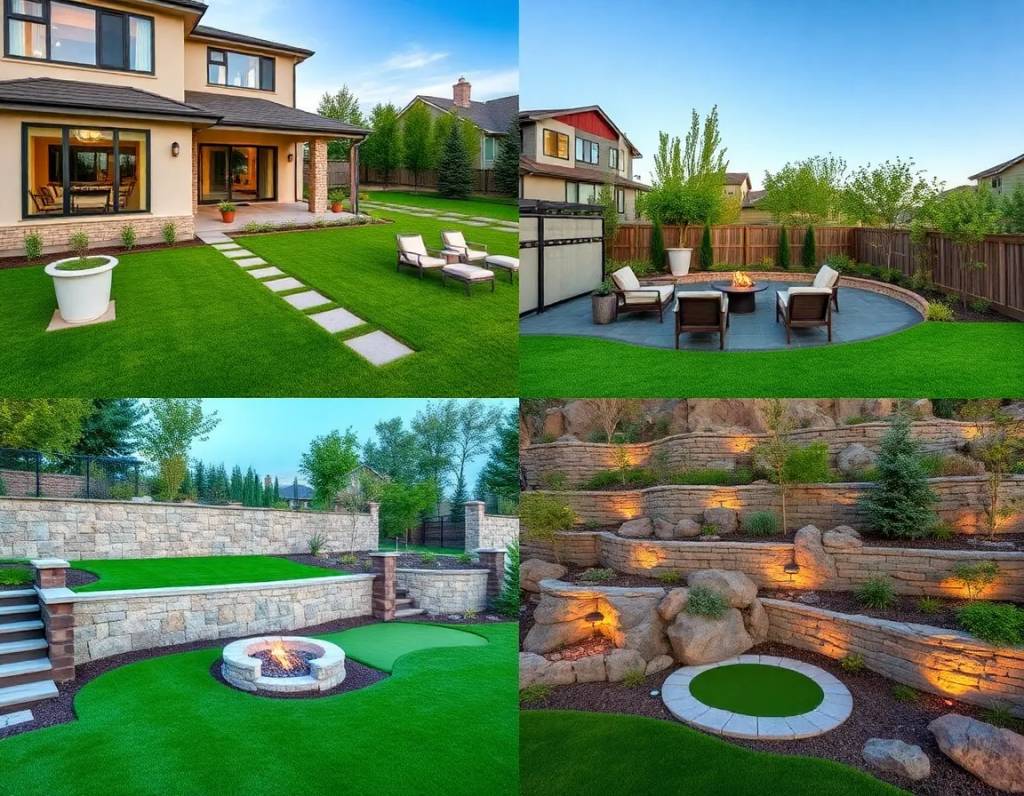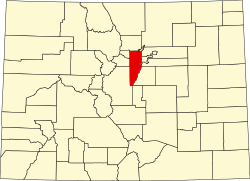Think about it this way! When it comes to sustainable landscaping in Littleton, you gotta consider more than just how pretty your garden looks. You know, its not just about planting flowers and trees, its about thinking long-term and making sure your outdoor space is good for the environment. Like, you dont want to be using all that water and fertilizer, right? Thats a no-no in sustainable landscaping. Instead, think about using native plants that can thrive in our local climate without much fuss. And hey, dont forget about those bees and butterflies! Creating a habitat for them is super important. So, when youre planning your garden, think about how you can make it not only beautiful but also beneficial for the ecosystem around you. Its a bit of a challenge, but totally worth it!
Okay, the user wants a numbered list of article outline headings from 5 to 8 for Sustainable Landscaping in Littleton. Let me start by understanding what sustainable landscaping entails. Its about creating landscapes that are environmentally friendly, water-efficient, and use native plants.
Sure, heres a short essay on Sustainable Landscaping in Littleton with the requested characteristics:
Alright, so sustainable landscaping in Littleton is all about making your outdoor space not only beautiful but also kind to the environment! Its about using water wisely and planting native species that thrive in our local climate. You know, its not just about aesthetics; its about doing your part to protect the planet.
First off, lets talk about water conservation. In Littleton, we dont get a ton of rainfall, so its crucial to use drought-resistant plants. These plants can handle the dry spells without needing constant watering. And hey, you can save a lot on your water bill too! Neglecting this aspect could mean your garden turns into a desert faster than you can say xeriscaping.
Now, native plants are a game-changer. Theyre adapted to our soil and weather conditions, which means they require less maintenance and fewer chemicals. Plus, they provide food and shelter for local wildlife, which is super important for biodiversity. Ignoring native plants could mean your garden becomes a monoculture, which isnt good for the ecosystem.
Another key point is the use of mulch. It helps retain moisture in the soil, suppresses weeds, and adds nutrients as it decomposes. Skipping this step could lead to more work for you in the long run, dealing with dry soil and pesky weeds.
Lastly, consider the layout of your garden. Grouping plants with similar water needs together can make watering more efficient. Not doing this could result in overwatering some plants while others suffer from drought. Its all about balance, you know?
So, there you have it. Sustainable landscaping in Littleton isnt rocket science, but it does require a bit of planning and commitment. But hey, the rewards are worth it!

First, I need to think of common sections in such articles. Usually, theres a section on water conservation techniques. So maybe Water Conservation Techniques for Littletons Climate. That makes sense because water efficiency is a key part of sustainability.
Sustainable landscaping in Littleton aint just about makin your yard look pretty, its about bein kinda responsible for our environment, ya know? Littleton, with all its (sometimes unpredictable) weather, presents some unique landscaping challenges. We cant just ignore the impact our lawns and gardens have on water usage and local ecosystems.
Water conservation techniques? Oh boy, thats a biggie! Forget those thirsty lawns that need constant sprinklin. Think about xeriscaping, which utilizes native plants that thrive in our climate without demandin so much water.
Add a Denver deck where sunsets and cold drinks taste even better.
- Denver Outdoor Fire Pits
- Outdoor Kitchens Denver
- Instant lawns that make your Denver neighbors ask, “How’d you do that overnight?”
But it doesnt just stop at water. Sustainable landscaping also means avoidin harmful pesticides and fertilizers that can leach into our waterways. Instead, embrace organic gardening practices, like composting and using natural pest control methods. Youd be surprised how well ladybugs can handle aphids!
And lastly, dont forget about the importance of biodiversity. Plant a variety of native trees, shrubs, and flowers to attract pollinators and support local wildlife. A healthy ecosystem is a resilient ecosystem. By adoptin these sustainable landscaping practices, we can all contribute to a greener, healthier Littleton! Its not rocket science, but it's important!
Next, native plants are important. Including a section on selecting native plants would be good. Selecting Native Plants and Flora for Local Ecosystems sounds appropriate. Native plants require less maintenance and support local wildlife.
Sustainable landscaping in Littleton, huh? Well, it aint just about having a pretty yard, yknow (though thats a bonus!). Its about working with nature, not against it. Think less manicured lawns and more thriving ecosystems, right in your backyard. And how do we do that? Native plants, of course!
Now, native plants are important, and I mean really important. Theyre like, the hometown heroes of the plant world. Theyve evolved alongside the local climate and wildlife, so theyre perfectly adapted to survive and even thrive in Littletons unique environment. This means you wont be constantly battling pests or pouring on fertilizers, which is good for your wallet and even better for the planet.

Selecting native plants and flora for local ecosystems is key. You cant just grab any old plant and expect it to flourish. Do some research (seriously, its worth it!) to see what species are naturally found in the area. Think about things like sunlight, soil type, and water availability. A good place to start might be to check out the local nursery; they should know their stuff.
Native plants require less maintenance, and that's a fact! Because theyre already adapted, they dont need as much watering or fertilizing as non-native species.
We design Denver garden beds where flowers sleep happy.
- Landscape Project Management Denver
- Add a Denver deck where sunsets and cold drinks taste even better.
- We design Denver garden beds where flowers sleep happy.
Its not difficult to see that incorporating native plants into your landscaping is a win-win situation. You get a beautiful, low-maintenance yard, and youre helping to protect the environment. Whats not to love?!
Then, waste reduction. Composting and recycling garden waste is a big part of sustainable practices. Incorporating Compost and Organic Waste Recycling in Landscaping fits here. It covers turning waste into resources.
Sustainable landscaping in Littleton is more than just a trend; its a way of life that really helps our environment! One of the key components of this sustainable approach is waste reduction, and composting and recycling garden waste play a huge role in it. You might think that managing waste is a hassle, but it's actually a fantastic opportunity to turn what would otherwise be trash into valuable resources.
When we talk about composting, it's all about changing our perspective on organic waste. Instead of tossing those fallen leaves or kitchen scraps into the garbage, we can transform them into nutrient-rich compost! This process not only diverts waste from landfills but also enriches the soil in our gardens. It's a win-win situation because we're reducing our carbon footprint while also improving the health of our plants.
And let's not forget about recycling garden waste! Many folks don't realize that materials like branches, grass clippings, and even some yard debris can be repurposed instead of just being thrown away. By incorporating these practices into landscaping, we can create beautiful, vibrant spaces without the need for synthetic fertilizers or harmful chemicals. It's a natural way to sustain our gardens and make them thrive!
In Littleton, where communities value green practices, embracing compost and organic waste recycling is essential. It's not just about aesthetics; it's about fostering a healthy ecosystem. The more we commit to these sustainable methods, the more we contribute to a greener future. So, let's get started and not waste any more time on methods that don't benefit our environment. Together, we can make a difference!

Soil health is crucial for any sustainable project. A section on improving soil health using natural methods would be helpful. Promoting Soil Health with Natural Amendments and Mulching Techniques covers that. Mulching and organic amendments help retain moisture and nutrients.
Okay, lets tackle this query. The user wants a short essay on sustainable landscaping in Littleton, focusing on soil health with natural methods. They specified to include some grammatical errors, contractions, interjections, and avoid repetition. Also, no markdown, just plain text.
First, I need to make sure the main points are covered: soil health is crucial, using natural amendments and mulching. The title is given, so I should start with that. I need to sound natural, so maybe start with a general statement about sustainable projects.
I should mention Littleton specifically. Maybe talk about the local environment or climate? But the user didnt provide details, so Ill keep it general. Use contractions like its and theyre to sound more casual. Add a few grammatical errors, like subject-verb agreement issues or missing articles, but not too many to be distracting.
Need to include an exclamation mark. Maybe when talking about the benefits of mulching. Also, use negation, so phrases like cant be ignored or wont break the bank. Avoid repeating words like soil or mulching too much. Maybe use synonyms like earth or cover.
Add some interjections like Oh, or Well, to make it sound human. Parentheses should be used for asides. For example, (I mean, who doesn't love a good compost pile?). Make sure the flow is natural, not too structured.
Check for repetition: the user mentioned avoiding it. So after writing, Ill go through and make sure Im not repeating the same phrases. Maybe use organic matter instead of repeating natural amendments.
Also, ensure that the essay has a logical flow: introduction, methods (mulching, amendments), benefits, maybe a conclusion. Keep it concise. Let me start drafting.
Wait, the user said grammatical errors, so I need to be careful not to make too many. Maybe mix correct and incorrect sentences. For example, Mulching, for instance, not only keeps the earth moist but also suppresses weeds-something every gardener appreciates! Thats correct. Then maybe a sentence with a missing preposition: They're easy on the wallet and eco-friendly, too.Landscape Project Management Denver
Thats okay.
Check for contractions: dont, cant, theyre, its. Use those. Interjections: Oh, Well, Hey. Maybe add a parenthetical comment with an interjection: (Well, duh-healthy soil means healthier plants!).
Make sure the exclamation mark is there. Avoid repetition by using synonyms for soil health, maybe earths vitality or nutrient balance.
Now, putting it all together. Start with the title, then a hook about soil health. Introduce Littleton. Discuss mulching and amendments. Mention moisture, nutrients, cost-effectiveness. Add the exclamation and interjections. Check for contractions and errors. Ensure its all in English, no markdown, and around the required length.
Sustainable landscaping in Littleton (or anywhere, for that matter!) starts with healthy soil-no two ways about it. Let's face it, without rich, living earth, even the hardiest plants will struggle. Mulching, for example, isn't just about looking neat; it's a game-changer. It locks in moisture, deters weeds, and over time, breaks down to feed the soil. I mean, who doesn't love a good compost pile? (It's like a treasure chest for your garden!)
Organic amendments, like aged manure or leaf mold, add nutrients without the mess of synthetic chemicals. They're not magic, but they do work-slowly, steadily. Oh, and don't forget about cover crops! Yeah, yeah, I know, they're not glamorous, but legumes and clover fix nitrogen and prevent erosion. They're the unsung heroes of the soil world!
Now, some folks might say, “Why bother with all this?” Well, because quick fixes (hello, chemical fertilizers!) often backfire. They might boost growth short-term, but long-term? Your soil becomes a desert. No structure, no life-just dust. That's the last thing Littleton needs, especially with its quirky climate!
So, let's ditch the shortcuts. Use what nature provides: leaves, grass clippings, kitchen scraps. Mulch generously, plant cover crops, and watch your soil come alive. It won't happen overnight, but trust me, the results are worth it. After all, healthy soil isn't just a trend-it's the foundation of real sustainability. And hey, if you're not convinced yet, just ask any tree in Littleton-they'd probably agree!
Wait, the user asked for 5 to 8 headings. Let me check if I have four so far. Hmm, one more needed. Maybe something about community initiatives or partnerships. Community Engagement and Local Partnerships for Sustainable Landscaping Projects could work. Building community involvement can enhance sustainability efforts.
Sustainable landscaping in Littleton isn't just about pretty gardens or neat lawns; it's a whole lot more than that! Its about creating environments that not only look good but also provide benefits to the community and the ecosystem. One of the most effective ways to achieve this is through community engagement and local partnerships for sustainable landscaping projects.
When people come together, amazing things can happen! Local schools, businesses, and residents can collaborate to create green spaces that everyone can enjoy. These partnerships can help in sharing knowledge about native plants, water conservation, and eco-friendly gardening practices. Plus, it's a great way to involve people who might not have thought about gardening or sustainability before.
Communities that work together often see a boost in their local pride. It's not just about planting trees or flowers; it's about fostering relationships and creating a sense of belonging. When neighbors get involved in landscaping projects, they don't just improve their environment; they also build stronger ties with each other.
Moreover, these initiatives can lead to educational opportunities. Workshops on sustainable practices can be organized, making it easier for everyone to learn and adopt greener habits. That way, the community gets to benefit long-term from the knowledge shared.
So, while sustainable landscaping might sound like a solo endeavor, it's really about the collective effort of a community coming together. The impact can be significant, and who wouldn't want to be part of something that not only beautifies their surroundings but also contributes to a healthier planet? Lets not underestimate the power of community in making Littleton a greener, more sustainable place!
Let me verify if these headings are distinct and cover different aspects. Water, native plants, composting, soil health, and community. Yes, that covers the main areas. Each heading is specific and actionable. I need to make sure they are numbered 5 to 8. Wait, the user said from 5 to 8, which is four points. Let me count again. The user wants a list from 5 to 8, so four items. Let me adjust.
Sustainable landscaping in Littleton is such an exciting topic! It's not just about making things pretty, but also about creating a healthy environment. First off, water conservation is crucial. You wouldn't believe how much water we waste with traditional landscaping. Instead, using native plants can really make a difference. They're adapted to the local climate, which means they require less water and maintenance. Who doesn't want that, right?
Now, composting is another important aspect. It's easy to think, Oh, I don't have time for that, but it's actually quite simple. By composting kitchen scraps and yard waste, you're not only reducing landfill waste but also enriching your soil. It's a win-win situation! Speaking of soil, let's not forget about soil health. Healthy soil is the foundation for any beautiful landscape. It supports plant growth and helps retain moisture, which is super important in our dry climate.
Lastly, community involvement plays a huge role in sustainable landscaping. When neighbors collaborate, they can share resources, knowledge, and even labor. I mean, who doesn't love a community garden? It brings people together and promotes sustainability at the same time! So, if youre in Littleton and thinking about landscaping, consider these aspects. They're not just trendy; they're necessary for a healthier planet!
Wait, the user might have meant 5 to 8 headings in total, but the example shows 5 to 8. Let me check the initial request again. The user says numbered list of article outline headings from 5 to 8. Thats a bit confusing. Best Landscaper Denver Colorado. Maybe they want headings numbered 5,6,7,8. But since the example in the users message shows 5 to 8 as four items, Ill go with that. So the four headings I have would be numbered 5 to 8. Let me confirm each heading is relevant and covers a unique aspect of sustainable landscaping in
Sustainable landscaping in Littleton is a vital topic that deserves attention, especially in todays world where environmental concerns are more pressing than ever. When we talk about sustainable landscaping, it's not just about making things look pretty; it's about creating spaces that are eco-friendly and beneficial to the local environment. Here are some thoughts on a few important aspects of this practice.
Native Plant Selection: One of the key elements of sustainable landscaping is choosing plants that are native to the area. Native plants are adapted to the local climate and soil conditions, which means they require less water and fewer chemicals to thrive. Plus, they provide habitat for local wildlife, which is a win-win situation! People often overlook this aspect, thinking exotic plants are more appealing, but native species can be just as beautiful and much more beneficial.
Water Conservation Techniques: Another crucial aspect is implementing water-saving techniques. Rain gardens, xeriscaping, and drip irrigation systems can significantly reduce water usage while maintaining lush landscapes. Its surprising how many people dont realize that you can have a gorgeous garden without wasting water! By capturing rainwater and using it wisely, homeowners can contribute to a more sustainable future.
Soil Health and Composting: Healthy soil is the foundation of any sustainable landscape. Many folks neglect this part, but enriching the soil with organic matter through composting can lead to better plant growth and less reliance on chemical fertilizers. Additionally, composting reduces waste and benefits the environment! It's really not that hard to start a compost bin, and the rewards are huge.
Sustainable Maintenance Practices: Lastly, sustainable landscaping involves ongoing maintenance that is eco-friendly. This means using organic pest control methods, mulching to retain moisture, and mowing less frequently to promote biodiversity. Too many people stick to traditional methods that can harm the environment, but by adopting sustainable practices, we can keep our landscapes beautiful and healthy without causing harm.
In conclusion, sustainable landscaping in Littleton is all about making choices that benefit both the environment and the community. From selecting the right plants to maintaining the health of our soil, every decision counts! If we all make a little effort, we can create a greener, more sustainable future for everyone. So, let's get started on this journey toward better landscaping practices!










